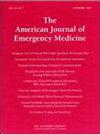成人重型外伤合并孤立性胸腹外伤合并失血性休克的复苏性血管内球囊闭塞术(REBOA)疗效观察
IF 2.2
3区 医学
Q1 EMERGENCY MEDICINE
引用次数: 0
摘要
背景:关于严重胸部或腹部创伤患者使用REBOA相关的死亡率结果,文献存在矛盾。我们的研究旨在评估REBOA在成人创伤患者重型胸腹外伤失血性休克中应用的益处和负面影响。方法回顾性队列分析利用美国外科医师学会创伤质量改善计划参与者使用文件(ACS-TQIP-PUF)数据库,对2017年至2023年接受REBOA置入术的严重孤立性胸腹创伤成人患者进行评估。根据REBOA区、损伤类型和创伤中心水平对患者进行分层。主要结局包括急诊科(ED)和24小时死亡率。次要结局包括出血控制时间、输血量和并发症。结果重型成人创伤合并胸部或腹部损伤患者中,REBOA与钝性和穿透性损伤患者的死亡率(aOR: 15.456, 95% CI: 3.340 ~ 71.516, p < 0.001)、4 h输血需求(β = 3177.081, 95% CI: 59.315 ~ 6294.848, p = 0.046)和24 h输血需求(β = 2750.609, 95% CI: 704.078 ~ 4797.141, p = 0.008)显著相关。在二级创伤中心接受REBOA的患者24小时死亡率更高。在出血控制时间和并发症发生率方面无显著差异。结论:在严重胸腹创伤的成人患者中使用REBOA会导致死亡率和输血需求的增加,即使按REBOA区放置和创伤中心水平分层。对于严重受伤的患者,应根据具体情况谨慎考虑REBOA的使用。本文章由计算机程序翻译,如有差异,请以英文原文为准。
Outcomes of resuscitative endovascular balloon occlusion of the aorta (REBOA) in severely injured adult trauma patients with isolated thoracic or abdominal trauma in Hemorrhagic shock
Background
There is conflicting literature regarding mortality outcomes associated with REBOA usage in patients with severe thoracic or abdominal trauma. Our study aims to assess the benefits and negative implications of REBOA use in adult trauma patients in hemorrhagic shock with severe thoracic or abdominal injuries.
Methods
This retrospective cohort analysis utilized the American College of Surgeons Trauma Quality Improvement Program Participant Use File (ACS-TQIP-PUF) database from 2017 to 2023 to evaluate adult patients with severe isolated thoracic or abdominal trauma undergoing REBOA placement. Patients were stratified by REBOA zone, type of injury, and trauma center level. Primary outcomes included Emergency Department (ED) and 24-h mortality. Secondary outcomes included time to hemorrhage control, transfusion volumes, and complications.
Results
In severely injured adult trauma patients with thoracic or abdominal injuries, REBOA was significantly associated with increased mortality (aOR: 15.456, 95 % CI: 3.340–71.516, p < 0.001), 4-h transfusion requirements (β = 3177.081, 95 % CI: 59.315–6294.848, p = 0.046), and 24-h transfusion requirements (β = 2750.609, 95 % CI: 704.078–4797.141, p = 0.008) in both blunt and penetrating injuries. Patients who underwent REBOA at level II trauma centers had greater odds of 24-h mortality. No significant differences were observed in time to hemorrhage control or complication rates.
Conclusion
REBOA use in adult trauma patients with severe thoracic or abdominal trauma consistently led to increased mortality and blood transfusion requirements even when outcomes were stratified by REBOA zone placement and trauma center level. REBOA use should be cautiously considered on a case-by-case basis in severely injured patients.
求助全文
通过发布文献求助,成功后即可免费获取论文全文。
去求助
来源期刊
CiteScore
6.00
自引率
5.60%
发文量
730
审稿时长
42 days
期刊介绍:
A distinctive blend of practicality and scholarliness makes the American Journal of Emergency Medicine a key source for information on emergency medical care. Covering all activities concerned with emergency medicine, it is the journal to turn to for information to help increase the ability to understand, recognize and treat emergency conditions. Issues contain clinical articles, case reports, review articles, editorials, international notes, book reviews and more.

 求助内容:
求助内容: 应助结果提醒方式:
应助结果提醒方式:


